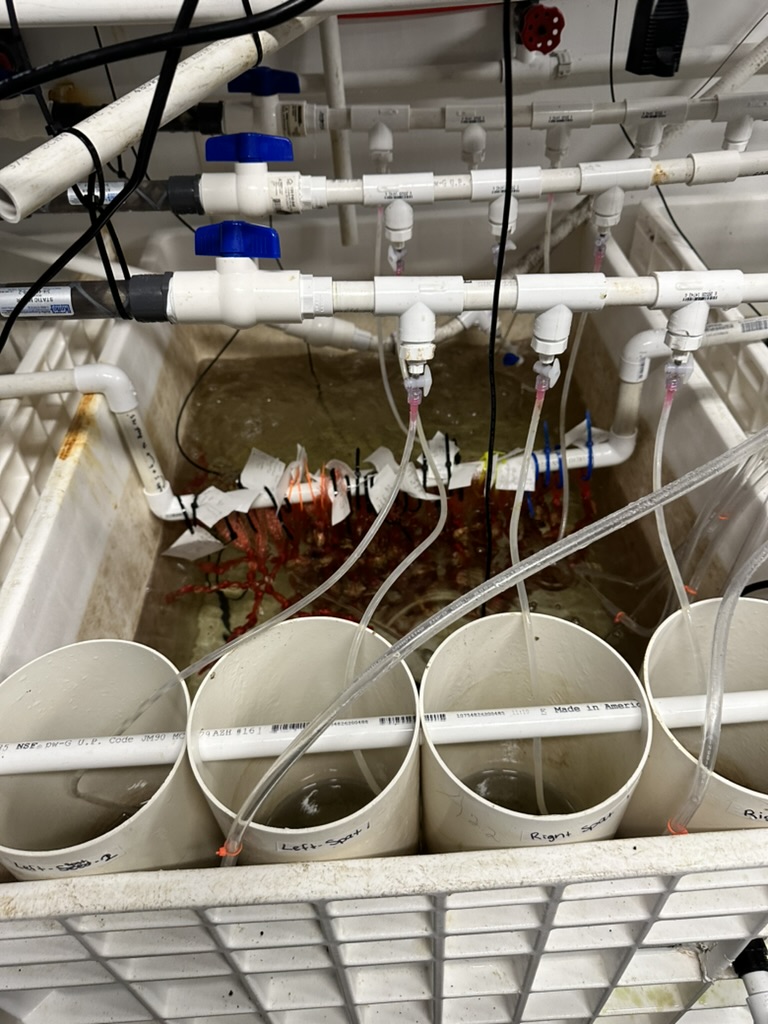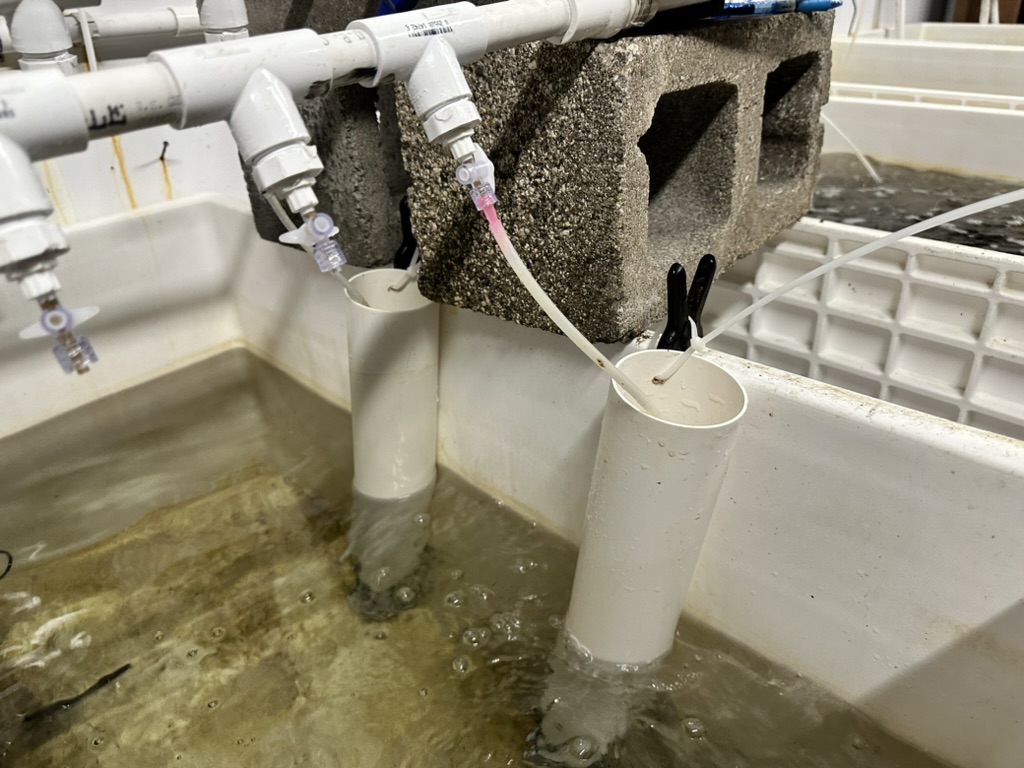Point Whitney field day to start individual growth experiment and plan for new seed exposure work
This post details field day and project design on 5 March 2024 at Point Whitney.
Overview
Today Steven and I were out at Point Whitney for the following tasks for the lifestage carry over project and WSG/USDA work:
- Individually isolate adult and seed oysters from the lifestage carryover project for tracking individual growth rates over the next few weeks to months
- Relaunch Hobo loggers
- Figure out next round of seed and/or adult exposures and decide on location for exposures
- Set up water level monitor on Apex system
See previous posts on the lifestage carryover project in my notebook here and Eric’s notebook here.
The GitHub repository for the lifestage carryover project is here.
Individual growth experiment: Lifestage carryover project
Today, I isolated the remaining adults and seed and pooled spat for continued growth measurements for the lifestage carryover project. We noticed from previous growth measurements that the spat may be starting to show differential growth from their original hardening treatments back in October. Because of this, we want to start increasing the temperature over a few weeks and see if there are any differential growth responses in the remaining life stages.

Today, I took out all adults and added them into new, labeled bags that were hanging in one tank. The oysters were added into 3 bags per treatment with 3-4 oysters in each bag. Oysters were separated by tying the bag in between each oyster. Note that I gave them extra room to open/feed and grow, but we should check this each time we do measurements to make sure they have enough room.
Oysters can now be identified by the bag label and the position in each bag. Oyster #1 is the top oyster by the tag, #2 is the next one down, and so on. The tag on each bag has the tag ID (e.g., Blue or Bird), the bag number (e.g., Bag 1, Bag 2), and treatment (treated or control). I also included a visual on each tag that shows the order of oyster ID’s (e.g., #1-#4) descending down the bag.
Here are adults in the hanging bags:

After I added oysters to the bags I measured them while in the bags with our new digital caliper. It was pretty easy to measure them inside the bags. As before, length was measured as the maximum length to the nearest 0.1 mm.
For future growth sampling, we can just hold up a bag (without even taking it off the rack), do the measurements, and move on to the next one.
We do need to keep the paper tags out of the water. I made these with water resistant paper, but the tags shouldn’t be submerged.
I then repeated this process with the remaining seed from “left-seed” and “right-seed” containers. I added 6 seed per hanging bag. There were about 15-20 seed of each type.
Here are seed in the hanging bags:

Here are all hanging bags in the tank:


The table below shows the number of bags and animals from each group.
| Tag | Treatment | Bag | Oyster IDs |
|---|---|---|---|
| Blue | Treated | 1 | 1-4 |
| Blue | Treated | 2 | 1-4 |
| Blue | Treated | 3 | 1-4 |
| Blue | Treated | 4 | 1-3 |
| Bird | Treated | 1 | 1-4 |
| Bird | Treated | 2 | 1-4 |
| Bird | Treated | 3 | 1-4 |
| Bird | Treated | 4 | 1-3 |
| Blue | Control | 1 | 1-4 |
| Blue | Control | 2 | 1-4 |
| Blue | Control | 3 | 1-4 |
| Blue | Control | 4 | 1-3 |
| Bird | Control | 1 | 1-4 |
| Bird | Control | 2 | 1-4 |
| Bird | Control | 3 | 1-4 |
| Bird | Control | 4 | 1-3 |
| Orange | Control | 1 | 1-4 |
| Orange | Control | 2 | 1-4 |
| Orange | Control | 3 | 1-4 |
| Orange | Control | 4 | 1-3 |
| Orange | Treated | 1 | 1-4 |
| Orange | Treated | 2 | 1-4 |
| Orange | Treated | 3 | 1-4 |
| Orange | Treated | 4 | 1-3 |
| Left Seed | Treated | 1 | 1-6 |
| Left Seed | Treated | 2 | 1-6 |
| Left Seed | Treated | 3 | 1-6 |
| Right Seed | Control | 1 | 1-6 |
| Right Seed | Control | 2 | 1-6 |
| Right Seed | Control | 3 | 1-6 |
All animals are together in one tank. We need the other two tanks for additional work. We will ramp the temperature by 2°C in this tank each week and conduct individual growth measurements every 1-2 weeks.
Finally, I moved the spat from “left-spat” and “right-spat” into the tank. I took photos of the spat for growth measurements in ImageJ later on.
Photo for growth measurements of left (treated) seed:

Photo for growth measurements of right (control) seed:

I then added a second container for each group to spread out the spat a bit.
Here are the spat containers in the tanks:


We will continue to take photographs of the spat for growth measurements.
Planning adult and seed exposures and outplanting
Steven talked with hatchery staff today to develop a plan for the next set of exposures. Here are the decisions we made and ideas we had:
Adults
- Matt is outplanting bags of adult oysters over the next few weeks. We are going to conduct an acute stress conditioning on adults and outplant them in parallel with Matt’s outplanting.
- We will do this by bringing adults into the lab and setting up one tank (likely the far left tank) to run a cyclic elevated temperature profiles using a combination of the Apex system, timers, and thermostat heaters.
- We need to next decide what our temperature treatments will be. In October, Eric conditioned oysters at 25°C for 6 h each day for 14 days. We could try to do a shorter but higher temperature exposure for this round. We will aim for 1 week exposures.
- Profiles could include 25°C-30°C for 2-6 h each day for 7 days. We will look at mortality from survival tests (described below) and that will help us decide the target temperature.
- We will talk with Matt about future outplants and see if we can try a few different cohorts of adults with different profiles over the next few weeks-months.
- This will allow us to compare growth and survival of our hardened adults with ambient/control adults.
Seed
- We also have access to excess seed from Point Whitney.
- Steven set up 4 trays of seed today that we will use as 2 ambient and 2 high trays.
- We looked around the hatchery for different tank and exposure options, but after talking with staff the easiest approach and the most applicable approach for industry will be to try a 1 week short term, acute exposure.
- We will do this by heating a tank (probably the far right white tank) to a target temperature and submerging the trays for a short length of time once per week.
- We will continue this until we have the opportunity to outplant them. We need to decide on what this time frame looks like.
- We will use results of the survival test we did today (described below) to help us pick temperature treatments. We will likely try something like a weekly 30 min -2 h exposure at 30-32°C.
- We will then be able to compare our stress hardened seed to ambient seed using lab assays, respirometry, and field performance.
- We have a lot of seed, so this also gives us the opportunity to run enzyme, physiology, or molecular assays.
Survival test for adults and seed
To test an extreme stress scenario, we exposed adult and seed for our next round of exposures to 31-32°C for 30 minutes. We did this by submerging some adults and seed in a heated bucket. We took them out and put them back in an ambient tank (tank on the right; isolated in case they die). We will check on them next week. If they live, we at least have some idea of the acute stress they can handle without mortality. If they die, we know we need to lower our temperatures.
Here are the tubes hanging in the right tank at ambient:

Hobo loggers and Apex system
We downloaded data from the Hobo loggers and Steven will upload them to our GitHub here. Ariana will work on plotting the data. These loggers will have our data from the lifestage carryover sampling from last week. Loggers downloaded were SSN 20174087 and SSN 20174083.
Here are the logger settings for launched loggers today. We need to do some repair or battery replacement on the loggers we have at the hatchery - many failed to launch today.
| Logger | Settings | Location |
|---|---|---|
| 20174087 | 15 min intervals; 14:45 start | Middle tank w/ lifestage carry over oysters |
| 20174083 | 15 min intervals; 14:45 start | Right white tank |
| Unknown | 15 min intervals; 14:45 start | Outdoors in tray array - didn’t write down SSN; record when reading out |
Next week
Next week (March 11-15) we need to do the following:
- Check on survival of adults and seed from this week’s acute stress testing.
- Turn temperature up by 2°C in the lifestage carry over tank using the thermostat and one heater
- Bring in adults and start daily cyclic temperature conditiong in preparation for outplanting. Need to decide temperature based on survival from this week.
- If possible, run the first acute stress exposure on seed. Need to decide temperature based on survival from this week.
Ariana could go out Thursday or Friday next week, or Steven may go out on Tuesday or Wednesday.
The following week (March 18-22), we will need to do the following:
- Take a round of growth measurements in the lifestage carry over oysters
- Ramp the lifestage carry over oysters another 2°C
- Outplant adults along side Point Whitney outplants
- Conduct the second set of acute seed stress exposures.
Ariana could go out on Tuesday or Wednesday of that week.


